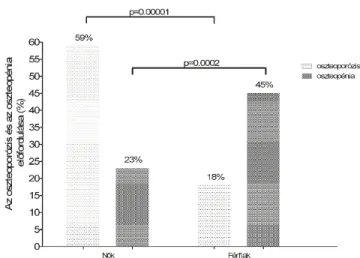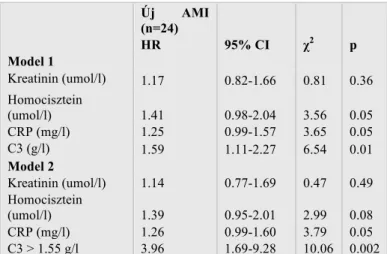Is extravascular and intravascular calcification connected in patients with atherosclerosis?
PhD Thesis Dr. Mátyás Fehérvári
Semmelweis University, Doctoral School of Clinical Medicine
Consultant:
Dr. Zoltán Szeberin, Ph.D.
Official reviewers:
Dr. Pál Soltész, Ds.C.
Dr. Marcell A. Szász, Ph.D.
Head of the Final Examination Comittee:
Professor Lajos Szollár, Ds.C.
Members of the Final Examination Committee:
Dr. György Wéber, Ds.C.
Dr. Zsolt Pécsvárady, PhD.
Budapest 2017
Introduction
Atherosclerosis and consequently cardiovascular disease is one of the leading causes of morbidity and mortality in western societies. Over the last decades the outcome of myocardial ischemia dramatically improved in Hungary. However, patients with peripheral artery disease (PAD) are still at high risk of severe morbidity and mortality. Therefore, investigations about PAD, such as this one, are very important in order to minimise complications and reduce mortality.
Aims
The connection between extravascular and intravascular calcification in patients with PAD was evaluated. The prevalence of osteoporosis and the possible mechanisms resulting in a connection between the 2 diseases were determined. Markers of calcification such as complement components or
Fetuin-a were compared to the clinical signs of lower limb ischemia. Furthermore, baseline level of these calcifying parameters were compared to cardiovascular outcome. These findings could help to prevent and treat osteoporosis in patients with PAD and to identify future cardiovascular risk in these patients.
Methods
In cross sectional and follow up studies patients with lower limb atherosclerosis and peripheral artery disease were recruited at the Heart and Vascular Department of Semmelweis University. Laboratory investigations (complement component3 and 4 (C3, C4), bone turnover markers, fetuin-A), angiography based Bollinger score (BS), clinical parameters such as ankle brachial Doppler index (ABI) and Fontaine stadiums and the site of the atherosclerotic lesion were evaluated too. To assess the extent of
generalised calcification an ultrasound based score was used. Bone mineral density (BMD) was measured with DEXA scan on 3 anatomical sites such at the lumbar fourth and fifth vertebras, the femoral and radial head. Our patients were followed up and monitored for any new cardiovascular event such as new onset of myocardial infarction (MI), embolic stroke or further vascular intervention.
Results
Previously to the enrolment in to the study 9% of our patients were diagnosed with osteoporosis.
Following the DEXA scan we identified further 31%
of patients suffering from osteoporosis and 37% of abnormally decreased bone mass (Figure 1.).
Figure 1. The prevalence of osteoporosis before and after DEXA scan
Osteoporosis was diagnosed in 59% of our female and 18% of our male subjects, which is higher than in similar aged non atherosclerotic population (female: 40%, male: 20%). Furthermore 45% of our male patients suffered with decreased bone mass (Figure 2.).
Figure 2. The prevalence of osteoporosis and osteopenia in male and female subjects.
A connection was found between the blood flow to a particular bony area where bone mineral density was measured (lumbar spine BMD and BS p=0.038, r=-0.467, femoral BMD and BS p=0.002, r=-0.642).
In case of intact blood flow to the bone these associations were not seen (lumbar BMD and BS p=0.514,r=0.118, femoral BMD and BS p=0.505,
r=0.120). Other previously described mechanisms did not affect the connection between the 2 diseases in our cohort. The level of bone turnover markers was not associated to atherosclerosis.The median follow up time was 2.7 years. High baseline level of C3 was associated to future myocardial infarction in patients with peripheral artery disease (HR=1.56, p=0.0001). A high and low risk patient group were created based on ROC analysis of C3. There was a significant difference in the survival of these groups (p=0.0001) (Figure 3.).
Figure 3. Kaplan Meier analysis. Survival of high and low risk patient groups.
Table 1. Regression analysis. The connection between C3 and MI is independent of CRP, homocisteine and creatinine
Furthermore, the connection between C3 and new myocardial infarction was independent of CRP, homocysteine and creatinine (Table 1.). The level of the complement components was associated to the clinical parameters of lower limb ischemia (ABI and C3 p=0.014, r=-0.246, ABI and C4 p=0.011, r=- 0.259, BS and C3 p=0.028, r=-0.357) (Figure 4-5).
Új AMI
(n=24)
HR 95% CI χ2 p
Model 1
Kreatinin (umol/l) 1.17 0.82-1.66 0.81 0.36 Homocisztein
(umol/l) 1.41 0.98-2.04 3.56 0.05
CRP (mg/l) 1.25 0.99-1.57 3.65 0.05
C3 (g/l) 1.59 1.11-2.27 6.54 0.01
Model 2
Kreatinin (umol/l) 1.14 0.77-1.69 0.47 0.49 Homocisztein
(umol/l) 1.39 0.95-2.01 2.99 0.08
CRP (mg/l) 1.26 0.99-1.60 3.79 0.05
C3 > 1.55 g/l 3.96 1.69-9.28 10.06 0.002
Figure 4. C3 and C4 is associated to ankle-brachial pressure index
Figure 5. C3 is associated to Bollinger score
Conclusion
There is a connection between the extent of atherosclerosis and osteoporosis in patients with PAD. This is a result of the reduced blood flow to the bone due to atherosclerosis. The higher prevalence of osteoporosis in patients with PAD indicates regular DEXA scan and BMD measurement. Supportive therapy to preserve bone mass is also important. Complement 3 is an independent risk factor of future myocardial ischemia in lower limb atherosclerosis and it is associated to the clinical parameters of the disease.
Therefore, it is important to consider more frequent complement measurements to identify high risk patients.
List of Author`s Publications
Fehérvári M , Krepuska M , Széplaki G , Apor A , Sótonyi P , Prohászka Z , Acsády G , Szeberin Z The level of complement C3 is associated with the severity of atherosclerosis but not with arterial calcification in peripheral artery disease.
INTERNATIONAL ANGIOLOGY 33:(1) pp. 35- 41. (2014), IF:0.833
Fehérvári M , Sarkadi H , Krepuska M , Sótonyi P , Acsády G , Entz L , Lakatos P , Szeberin Z
Bone Mineral Density is Associated with Site- Specific Atherosclerosis in Patients with Severe Peripheral Artery Disease
CALCIFIED TISSUE INTERNATIONAL 93:(1) pp. 55-61. (2013), IF:2.748
Fehérvári M, Krepuska M , Csobay-Novák Cs , Lakatos P, Oláh Z , Acsády G, Szeberin Z A csontritkulás előfordulásának vizsgálata perifériás verőérbetegekben [Prevalence of osteoporosis in patients with severe peripheral artery disease]
ORVOSI HETILAP 154:(10) pp. 369-375. (2013)
Szeberin Z , Fehérvári M , Krepuska M, Apor A , Rimely E , Sarkadi H , Bíró G , Sótonyi P ,
Széplaki G , Szabolcs Z , Prohászka Z , Kalabay L , Acsády G
Fetuin-A serum levels in patients with aortic
aneurysms of Marfan syndrome and atherosclerosis EUROPEAN JOURNAL OF CLINICAL
INVESTIGATION 41:(2) pp. 176-182. (2011), IF: 3.018
Szeberin Z , Fehervári M , Krepuska M , Apor A , Rimely E , Sarkadi H , Széplaki G , Prohászka Z , Kalabay L , Acsády G
Serum fetuin-A levels inversely correlate with the severity of arterial calcification in patients with chronic lower extremity atherosclerosis without renal disease.
INTERNATIONAL ANGIOLOGY 30:(5) pp. 474- 480. (2011), IF:1.652
II. Other publications
Krepuska M , Szeberin Z , Sótonyi P , Sarkadi H, Fehervári M , Apor A , Rimely E , Prohászka Z , Acsády G
Serum level of soluble Hsp70 is associated with vascular calcification
CELL STRESS & CHAPERONES 16:(3) pp. 257- 265. (2011), IF:3.013
Szeberin Z , Dósa E , Fehérvári M , Csobay-Novák C , Pintér N , Entz L
Early- and long-term outcome after open surgical suprarenal aortic fenestration in patients with complicated acute type B aortic dissection
EUROPEAN JOURNAL OF VASCULAR AND ENDOVASCULAR SURGERY 50:(1) pp. 44-50.
(2015), IF: 2.976
Kovács H , Fehérvári M , Forgó B , Gősi G , Oláh Z , Csobay-Novák Cs , Entz L , Szeberin Z
Electiv infrarenalis aortaaneurysma sebészi kezelésének korai és késői mortalitása és
morbiditása [Early and late mortality and morbidity of elective infrarenal aortic aneurysm repair]
MAGYAR SEBÉSZET 67:(5) pp. 297-303. (2014) IF:0
Biró G , Szabó G , Fehervári M , Münch Z , Szeberin Z , Acsády G
Late outcome following open surgical management of secondary aortoenteric fistula.
LANGENBECKS ARCHIVES OF SURGERY 396:(8) pp. 1221-1229. (2011) IF:1.807
Szeberin Z , Münch Z , Fehérvári M , Bíró G , Entz L , Acsády G
Ezüst-acetáttal bevont Dacron grafttal végzett rekonstrukciós érmutétek középtávú eredményei MAGYAR SEBÉSZET 63:(6) pp. 369-373. (2010) IF:0


